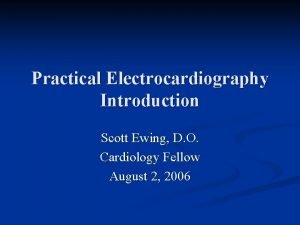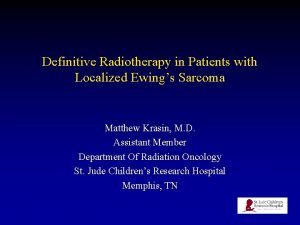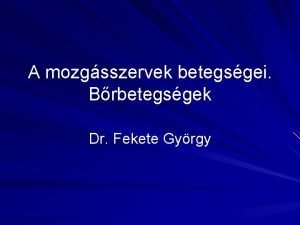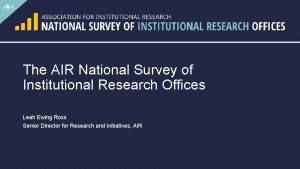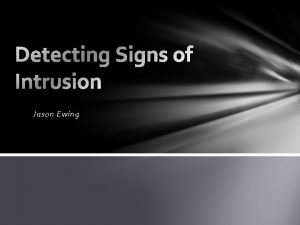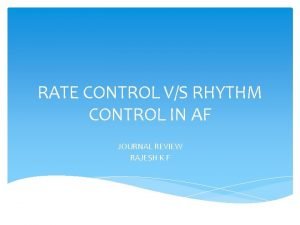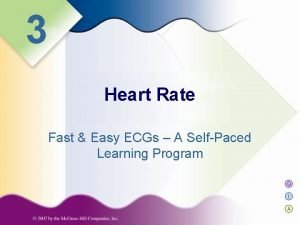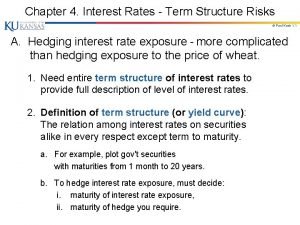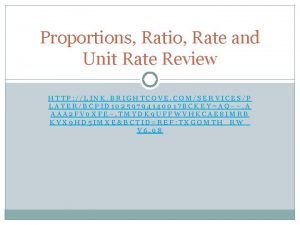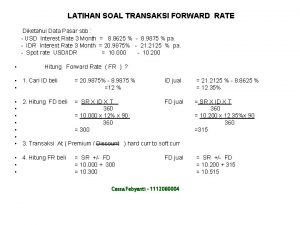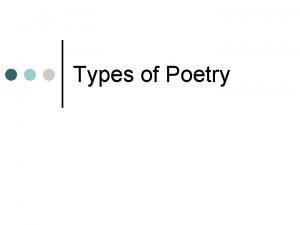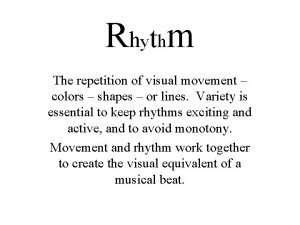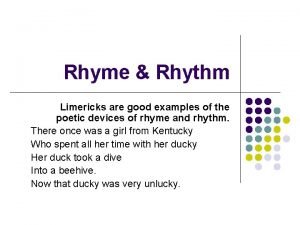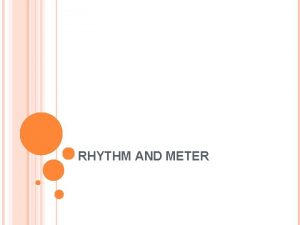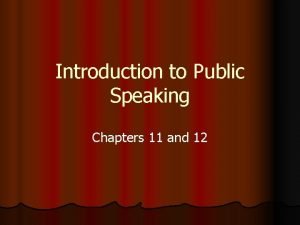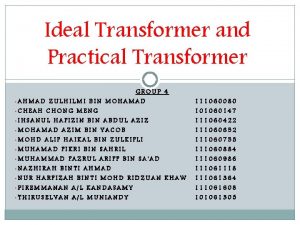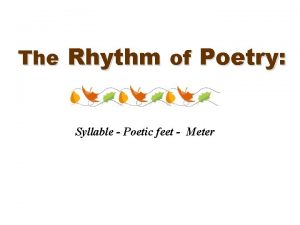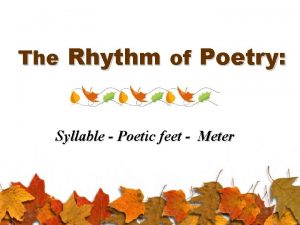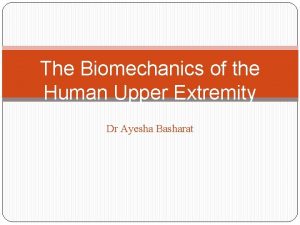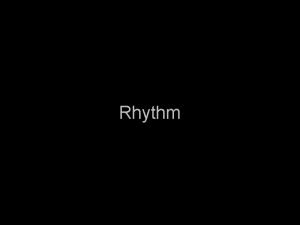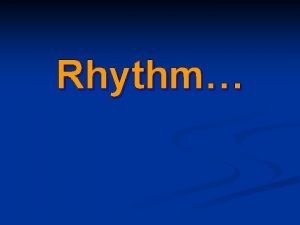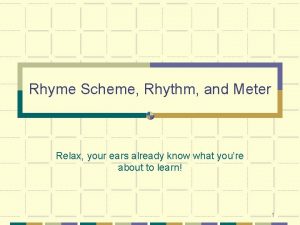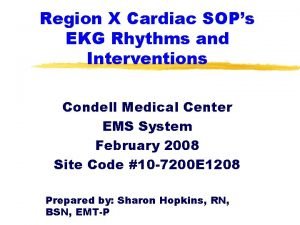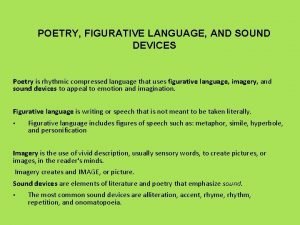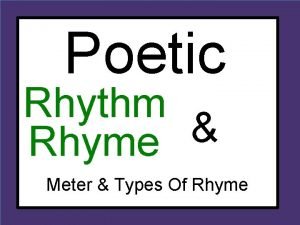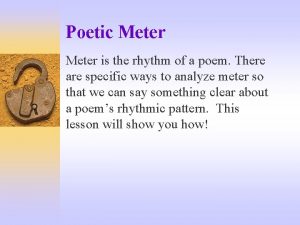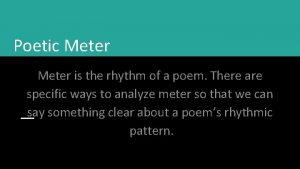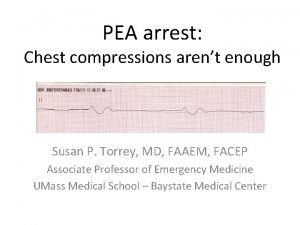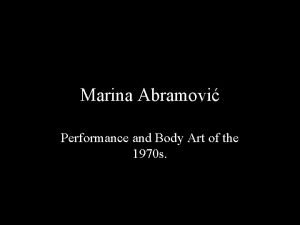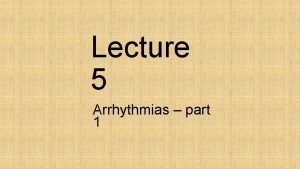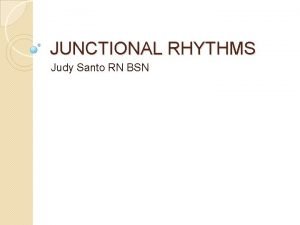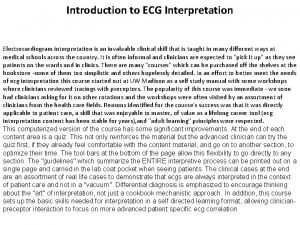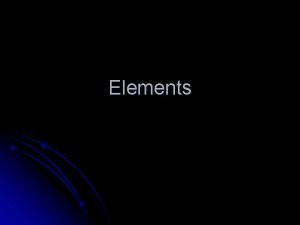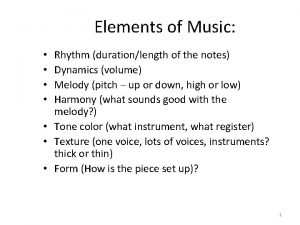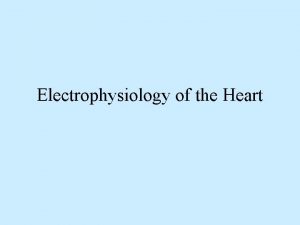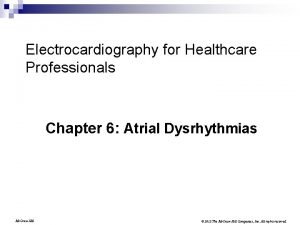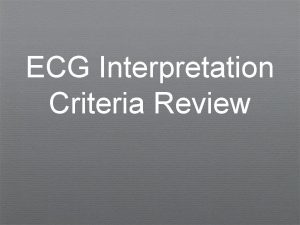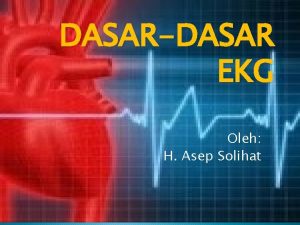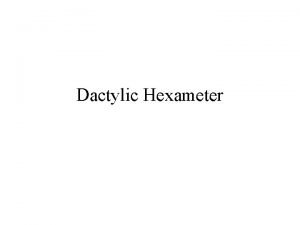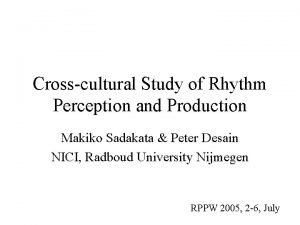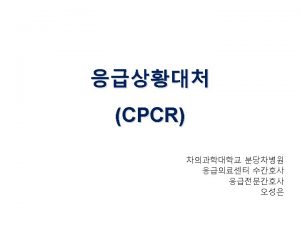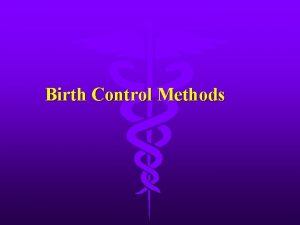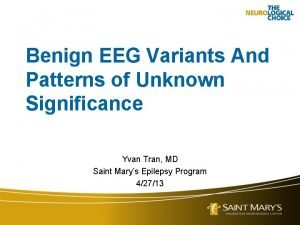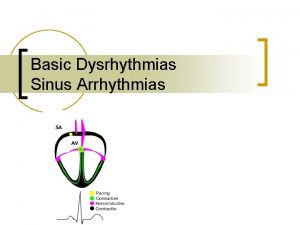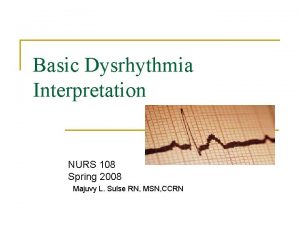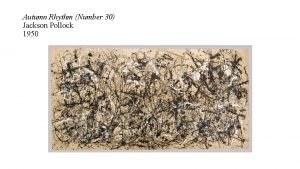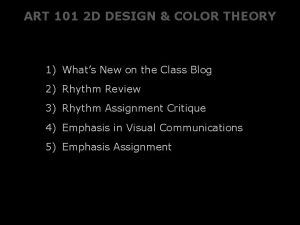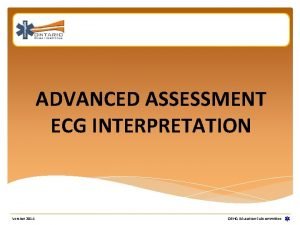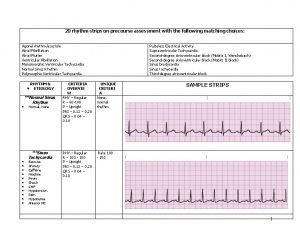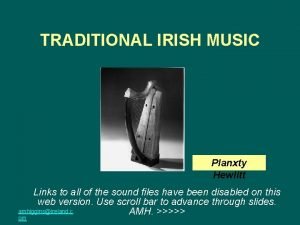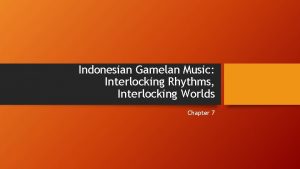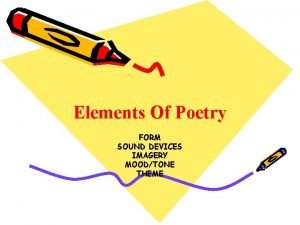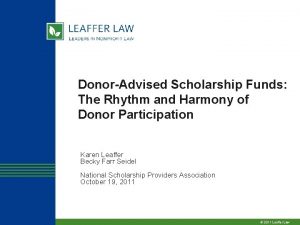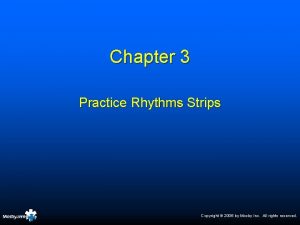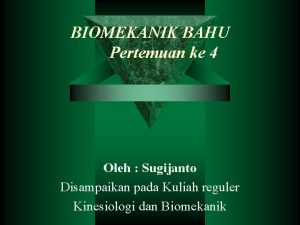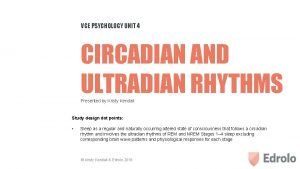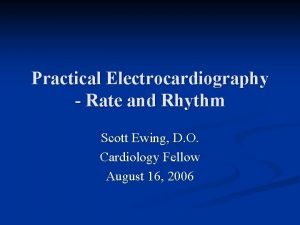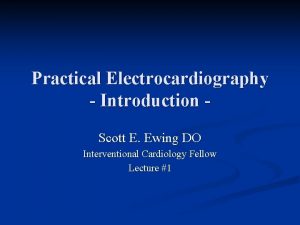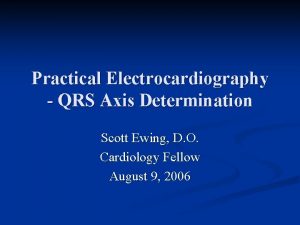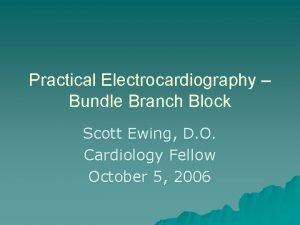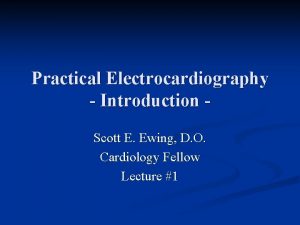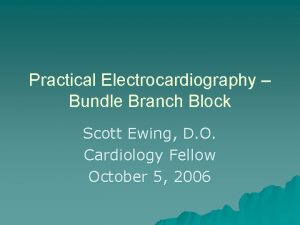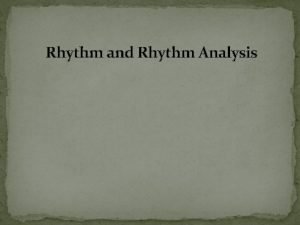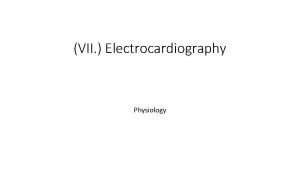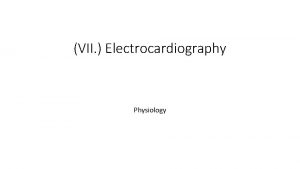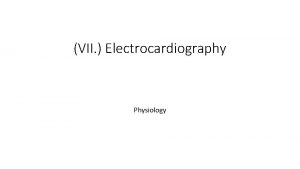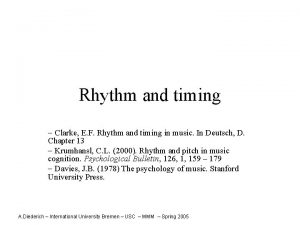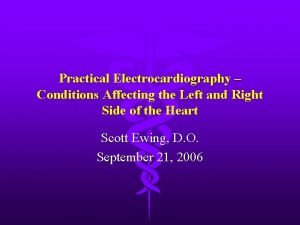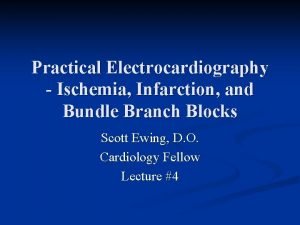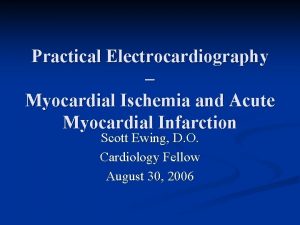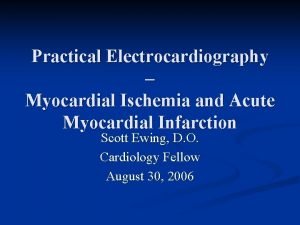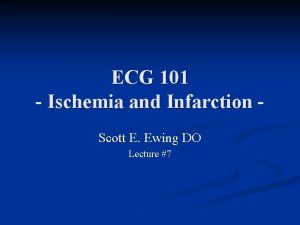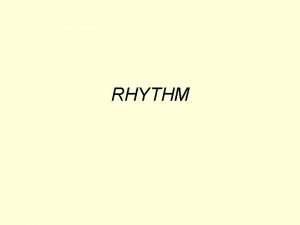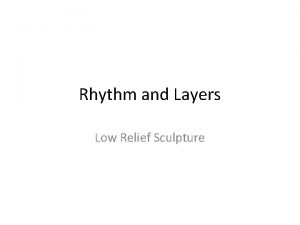Practical Electrocardiography Rate and Rhythm Scott E Ewing




















































































































- Slides: 116

Practical Electrocardiography - Rate and Rhythm Scott E. Ewing DO Interventional Cardiology Fellow Lecture #2

Review Electrophysiology n Anatomy n Depolarization n EKG Paper n Lead Placement n Normal EKG n Waves / Intervals / Segments n

Cardiac Action Potential n n SA node, AV, Purkinje cells display pacemaker activity (phase 4 depolarization) Body surface manifestation of the depolarization and repolarization waves n n n P wave is generated by atrial depolarization QRS by ventricular muscle depolarization T wave by ventricular repolarization PR interval is a measure of conduction time from atrium to ventricle QRS duration indicates the time required for all of the ventricular cells to be activated (i. e. , the intraventricular conduction time) QT interval reflects the duration of the ventricular action potential


Depolarization

EKG Frontal Plane

Normal EKG

QRS Complex

Waveform Review

8 -Step Method EKG Interpretation 1. 2. 3. 4. 5. 6. 7. 8. Rate Rhythm Axis P wave PR interval QRS complex QT interval ST segment and T wave

Rate Determination


Rate

Rate?

Rate?

Rate?

Rate?

Rate?

Rhythm Atrial n Junctional n Ventricular n Pacemaker n Last but not least n

Normal Sinus Rhythm

Normal Sinus Rhythm

Sinus Bradycardia

Sinus Bradycardia n Pathophysiology n n n Increased vagal tone in athletes Inferior wall myocardial infarction Digitalis glycosides, β blockers, CCB agents, class I antiarrhythmic agents, amiodarone Other drugs, toxins, environmental exposure (lithium, paclitaxel, toluene, dimethyl sulfoxide, topical ophthalmic acetylcholine, fentanyl, reserpine, clonidine) Electrolyte disorders Infection (diphtheria, rheumatic fever, viral myocarditis) Sleep apnea Hypoglycemia Hypothyroidism Hypothermia Increased intracranial pressure

Sinus Bradycardia

Sinus Tachycardia

Sinus Tachycardia n Pathophysiology n n n n n Hypoxia Hypovolemia / Sepsis Pain Fever Anxiety Hyperthyroidism PE Exercise Drugs (nicotine, caffeine, atropine, pseudoephedrine, cocaine, methamphetamines, ecstasy)

Sinus Tachycardia

Sinus Arrhythmia

Sinus Pause

Wandering Atrial Pacemaker

Atrial Tachycardia

PAC’s

Nonconducted PAC

Atrial Bigeminy

1 st Degree AV Block

1 st Degree AV Block n Pathophysiology n n PR interval represents time needed for electrical impulse from sinoatrial node to conduct through the atria, AV node, bundle of His, bundle branches, and Purkinje fibers PR interval prolongation due to conduction delay within the right atrium, the AV node, or the His Purkinje system AV nodal dysfunction accounts for the majority of cases 1 st degree AV block caused by conduction delay in the His Purkinje system often is associated with BBB

1 st Degree AV Block

2 nd Degree AV Block Mobitz Type I (Wenckebach)

Karel Frederik Wenckebach (1864 – 1940) n n n n 1988 – Doctorate University of Utrecht, Netherlands 1901 1910 – professor of IM Groningen, Netherlands 1911 1914 – professor of IM Strasbourg , France 1915 1929 – professor of IM Vienna, Austria, retired from his chair 1929 Early work concerned embryology, later pathology of heart and circulatory diseases 1903 1904 – first description of the beneficial effects of quinine alkaloids on arrhythmias and mainly in patients with auricular fibrillation of recent onset 1905 1906 – 2 nd degree AV block independently discovered by English physician John Hay and Wenckebach

2 nd Degree AV Block Mobitz Type I (Wenckebach) n Pathophysiology n n n Conduction disturbance in the AV node Rarely secondary to AV nodal structural abnormalities when the QRS complex is narrow in width and no underlying cardiac disease is present May be vagally mediated (well trained athletes, digoxin excess, neurally mediated syncopal syndromes) Vagally mediated AV block improves with exercise and may occur more commonly during sleep when parasympathetic tone dominates Cardioactive drugs (digoxin, β blockers, CCBs, certain antiarrhythmic drugs) Various inflammatory, infiltrative, metabolic, endocrine, collagen vascular disorders

2 nd Degree AV Block Mobitz Type I

2 nd Degree AV Block Mobitz Type I

2 nd Degree AV Block Mobitz Type II (Hay) n n Intermittent failure of conduction of P waves PR interval is constant (may be normal or prolonged) May include wide QRS May progress to complete 3 rd degree AV block

2 nd Degree AV Block Mobitz Type II

Woldemar Mobitz (1889 – 1951) n n n n n Born May 31, 1889 St. Petersburg, Russia, the son of a prominent surgeon 1908 – gymnasium Meiningen, Saxony 1914 – doctorate University of Munich Internship, hospital service, and assistant years in the surgical clinics in Berlin and Halle, and medical clinics Munich and Freiburg 1924 – first classified 2 nd degree AV block into Type I and II 1928 1943 – professor extraordinary at University of Freiburg in Breisgau Remained in Magdeburg until it was occupied by the Russian army in 1945 Suffered from laryngeal tuberculosis until his death April 11, 1951 Primary interest in cardiovascular circulation and arrhythmias

3 rd Degree Heart Block

3 rd Degree Heart Block n Pathophysiology n n n n n Class Ia antiarrhythmics (quinidine, procainamide) Class Ic antiarrhythmics (flecainide, propafenone) Class II antiarrhythmics (β blockers) Class III antiarrhythmics (amiodarone, sotalol, dofetilide, ibutilide) Class IV antiarrhythmics (CCBs) Digoxin or other cardiac glycosides Infection Profound hypervagotonicity Anterior wall MI Cardiomyopathy, eg, Lyme carditis and acute rheumatic fever

3 rd Degree Heart Block

3 rd Degree Heart Block

Atrial Fibrillation

Atrial Fibrillation n Pathophysiology n n n n Long standing hypertension Valvular heart disease (rheumatic) LVH CAD DM AMI CHF Pulmonary embolism Cardiomyopathy Pericarditis Hyperthyroidism ETOH (holiday heart) Postoperative revascularization Use of illegal drugs, such as cocaine or amphetamine derivatives Over the counter herbs (ephedra, ginseng) Idiopathic or “Lone” AF

Atrial Fibrillation

Atrial Fibrillation

Atrial Fibrillation

Atrial Fibrillation with WPW

Atrial Flutter

Atrial Flutter n Pathophysiology n n n Long standing hypertension Valvular heart disease (rheumatic) LVH CAD with or without depressed left ventricular function DM CHF Pulmonary embolism Pericarditis Hyperthyroidism Postoperative revascularization Digitalis toxicity

Atrial Flutter

Atrial Flutter

AV Node (Junctional) Origin

Junctional Rhythm

Accelerated Junctional Rhythm

Ventricular Origins

Premature Ventricular Contraction

Interpolated PVC’s

Multifocal PVC’s

PVC Couplet

PVC Triplet

Ventricular Bigeminy

Ventricular Trigeminy

Ventricular Escape Rhythm

Accelerated Idioventricular Rhythm

Wide Complex Tachycardia n Ventricular - regular n n Ventricular - irregular n n n Monomorphic ventricular tachycardia Fascicular tachycardia Right ventricular outflow tract tachycardia Torsades de pointes tachycardia Polymorphic ventricular tachycardia Supraventricular n n Bundle branch block with aberrant conduction Atrial tachycardia with pre excitation

Ventricular Tachycardia VT rate normally 120 300 bpm n Rhythm is regular or almost regular ( < 40 ms beat to beat variation), unless disturbed by the presence of capture or fusion beats n If a monomorphic broad complex tachycardia has an obviously irregular rhythm the most likely diagnosis is atrial fibrillation with either aberrant conduction or pre excitation n

Frontal Plane Axis n n QRS axis normally 30° to + 90°, with the axis most commonly ~60° With VT mean frontal plane axis changes and often bizarre n n Lead a. VR is situated in the frontal plane at 210° n n n Axis shift > 40° left or right suggestive of VT a. VR negative with normal cardiac axis a. VR positive extremely abnormal axis to the left or right a. VR positive originates close to the apex, with depolarization moving upwards towards base of the heart

Axis Shift Favoring VT

Direct Evidence of Independent Atrial Activity With VT, sinus node continues to initiate atrial contraction n P waves are dissociated from the QRS complexes and are positive in leads I and II n Atrial rate usually slower than the ventricular rate n AV dissociation usually diagnostic for VT, lack of direct evidence of independent P wave activity does not exclude the diagnosis n

AV Dissociation with VT

Indirect Evidence of Independent Atrial Activity n Capture beat Occasionally an atrial impulse may cause ventricular depolarization via the normal conduction system n Resulting QRS complex occurs earlier than expected and is narrow n Shows that even at rapid rates the conduction system is able to conduct normally, thus making a diagnosis of SVT with aberrancy unlikely n Capture beats are uncommon and their absence does not exclude the diagnosis n

Capture Beat

Indirect Evidence of Independent Atrial Activity n Fusion beats Occurs when a sinus beat conducts to the ventricles via the AV node and fuses with a beat arising in the ventricles n Resulting QRS complex has an appearance intermediate between a normal beat and a tachycardia beat n Fusion beats are uncommon and their absence does not exclude the diagnosis n

Fusion Beat

Fusion Beat

Indirect Evidence of Independent Atrial Activity n QRS concordance throughout the chest leads n n QRS complexes in precordial leads are either predominantly positive or predominantly negative Presence of concordance suggests that the tachycardia has a ventricular origin Positive concordance probably indicates that the origin of the tachycardia lies on the posterior ventricular wall; the wave of depolarization moves towards all the chest leads and produces positive complexes Similarly, negative concordance is thought to correlate with a tachycardia originating in the anterior ventricular wall





Answer: NSVT n n n 28 yo female with palpitations and lightheadedness Sinus rhythm (normal QTc) with non sustained monomorphic VT (starting 2 nd beat, rate 170 bpm) Ventricular beats have a LBBB pattern and inferior / borderline rightward QRS axis raising consideration of monomorphic VT arising from the RVOT Isolated PVCs and two ventricular couplets with the same morphology Retrograde P waves Patient had an idiopathic cardiomyopathy with global mild ventricular hypokinesis


Answer: Accelerated Idioventricular Rhythm n n n 67 yo man with previous acute MI with normal QRS duration Most consistent with AIVR, originating from the left ventricle and therefore accounting for the atypical RBBB morphology ST elevations in the precordial leads are likely due to the injury current from underlying acute myocardial infarction AIVR may be marker of reperfusion following acute MI 83 bpm too slow for VT and too fast for complete heart block


Answer: VT with Rate 170 bpm n n RBBB morphology is atypical (monomorphic R, rather than r. SR', in V 1), and the R: S ratio is less than 1 in V 6, both suggestive of ventricular tachycardia Most common underlying diagnosis in adult patients with sustained monomorphic VT is coronary heart disease status post AMI This patient had a non ischemic cardiomyopathy Morphology of the VT is suggestive of origin from the left side of the heart, near the base (RBBB with inferior/rightward axis)


Answer: VT with Underlying ST and AV Dissociation 77 yo with CAD n Wide complex tachycardia at 165 bpm and RBBB morphology n Underlying sinus tachycardia at 136 bpm and AV dissociation confirming the diagnosis of VT (Note the clear sinus P wave just after 5 th QRS) n QRS morphology and axis are consistent with origin of the VT from the posterior septum n Patient had a prior large inferior posterior MI n

Torsades de pointes Tachycardia n n Torsades de pointes (“twisting of points”) a polymorphic VT in which the cardiac axis rotates over a sequence of 5 20 beats QRS amplitude varies similarly, such that the complexes appear to twist around the baseline Usually associated with conditions that prolong QT interval Usually not sustained n n n Recur unless the underlying cause is corrected May be prolonged May degenerate into ventricular fibrillation Transient prolongation of the QT interval is often seen in AMI and may lead to torsades de pointes Management different from the management of other VTs

Torsades de pointes

Torsades de pointes n n n 62 yo woman on diuretics with syncope Syncope recurred during this ECG recording Serum potassium concentration was 2. 3 m. Eq/L



Answer: Torsade de pointes 74 yo woman with syncope with life threatening finding n Complex EKG showing n Underlying atrial fibrillation n Long QT(U) n Ventricular pacing with intermittent sensing failure n Run of torsade de pointes type of polymorphic ventricular tachycardia n

Pacemakers

Atrial Pacemaker

Ventricular Pacemaker

Pacemaker Failure to Sense

Pacemaker Failure to Capture

Pacemaker Output Failure

Pacemaker Fusion Beat

Last But Not Least


Ventricular Fibrillation n n 67 yo man at the onset of a cardiac arrest Arrow indicates the early occurring PVC that initiates the ventricular flutter that rapidly deteriorates into ventricular fibrillation

Ventricular Fibrillation


Answer: Ventricular Fibrillation / Ventricular Flutter n n 51 year male seen in the emergency department Classic EKG obtained during a VF cardiac arrest Findings typical of ventricular fibrillation with more organized ventricular electrical activity in the second half of the strip consistent with ventricular flutter Characteristic systematic variation in QRS axis of torsade is not seen here (although torsade may degenerate terminally into ventricular fibrillation)

Asystole

 Scott ewing md
Scott ewing md Vac ie ewing sarcoma nejm
Vac ie ewing sarcoma nejm Ali ewing
Ali ewing Ewing foundation
Ewing foundation Gottron jel
Gottron jel Ewing public schools
Ewing public schools Leah ewing ross
Leah ewing ross Jason ewing
Jason ewing Rate and rhythm control drugs
Rate and rhythm control drugs Transesophageal echocardiogram procedure
Transesophageal echocardiogram procedure 1500 method ecg
1500 method ecg What is real interest rate and nominal interest rate
What is real interest rate and nominal interest rate Growth is defined as an increase in
Growth is defined as an increase in Yield to worst
Yield to worst Spot rate and forward rate
Spot rate and forward rate Unit rate proportions
Unit rate proportions Cap rate interest rate relationship
Cap rate interest rate relationship Transaksi forward
Transaksi forward Real exchange rate vs nominal exchange rate
Real exchange rate vs nominal exchange rate Rhythm and rhyme
Rhythm and rhyme Regular rhythm in art
Regular rhythm in art The pickety fence poem
The pickety fence poem Difference between beat and rhythm
Difference between beat and rhythm Principles of art rhythm
Principles of art rhythm City 2 point perspective
City 2 point perspective Rhyme scheme
Rhyme scheme Beyoncé rhythm and blues
Beyoncé rhythm and blues A carefully prepared and rehearsed speech
A carefully prepared and rehearsed speech Practical extraction and reporting language
Practical extraction and reporting language Differences between ideal and practical transformer
Differences between ideal and practical transformer Natural science and technology grade 4 term 3
Natural science and technology grade 4 term 3 Strategic gender needs and practical gender needs
Strategic gender needs and practical gender needs Compare ideal and practical opamp
Compare ideal and practical opamp Inquiry in practical research 2
Inquiry in practical research 2 Practical extraction and reporting language
Practical extraction and reporting language Differentiate between ideal and practical transformer
Differentiate between ideal and practical transformer Formalism in literature
Formalism in literature Elseif perl
Elseif perl Gorry and scott morton grid
Gorry and scott morton grid Weak and strong syllable
Weak and strong syllable Graduated rhythm
Graduated rhythm Poetic feet
Poetic feet Types of pentameters
Types of pentameters Rhythm by transition dress
Rhythm by transition dress A consistent orderly or pleasing arrangement of parts
A consistent orderly or pleasing arrangement of parts Progressive rhythm in art
Progressive rhythm in art Scapulohumeral rhythm
Scapulohumeral rhythm Similar
Similar Rhythm
Rhythm Rhythm by opposition
Rhythm by opposition End rhyme in poetry
End rhyme in poetry Pea ekg
Pea ekg Gradation in interior design
Gradation in interior design Gradated rhythm in architecture
Gradated rhythm in architecture Rhythm stone
Rhythm stone Non conducted pac ecg
Non conducted pac ecg Rhythm definition figurative language
Rhythm definition figurative language Figurative sound device examples
Figurative sound device examples Internal rhyme
Internal rhyme Poetic meter
Poetic meter Common meter in poetry
Common meter in poetry Pulseless electrical activity ecg
Pulseless electrical activity ecg Marina abramovic rhythm 2
Marina abramovic rhythm 2 Limerick
Limerick Ventricular escape rhythm ecg
Ventricular escape rhythm ecg Judy santo
Judy santo Wandering atrial pacemaker ecg
Wandering atrial pacemaker ecg Gamelan indonesia rhythm
Gamelan indonesia rhythm Iambs examples
Iambs examples Idioventrikuler rhythm
Idioventrikuler rhythm Uneven rhythm movement
Uneven rhythm movement Principle of variety
Principle of variety Elements of poetry in literature
Elements of poetry in literature Rhythm vs melody
Rhythm vs melody Visual elements and principles of design matrix
Visual elements and principles of design matrix Agonal rhythm ecg
Agonal rhythm ecg Wandering pacemaker
Wandering pacemaker Acls rhythm recognition
Acls rhythm recognition Ventricular couplets
Ventricular couplets Letak lead ekg
Letak lead ekg Daily rythm
Daily rythm Dactylic meter
Dactylic meter Peter desain
Peter desain Arrangement of long and short sounds in music
Arrangement of long and short sounds in music Chapter 14 principles of hair design worksheet
Chapter 14 principles of hair design worksheet It is a pleasing arrangement of all parts of a garment
It is a pleasing arrangement of all parts of a garment Components of high quality cpr
Components of high quality cpr Rhythm method of birth control
Rhythm method of birth control Wicket rhythm eeg
Wicket rhythm eeg Ecg rhythm strip interpretation, basic lesson 7
Ecg rhythm strip interpretation, basic lesson 7 Unifocal pvcs
Unifocal pvcs Unity of mood in baroque music
Unity of mood in baroque music Autumn rhythm 1950
Autumn rhythm 1950 Legato rhythm art
Legato rhythm art Pjc rhythm
Pjc rhythm Autumn rhythm (number 30) 1950
Autumn rhythm (number 30) 1950 Rhythm identification
Rhythm identification Typical bar of rhythm reel
Typical bar of rhythm reel Sound device in poetry
Sound device in poetry Rr normal
Rr normal Country beleganjur
Country beleganjur Lines positioned between horizontal and vertical
Lines positioned between horizontal and vertical Floral arrangement shapes
Floral arrangement shapes Mood
Mood Rhythm international scholarship
Rhythm international scholarship Rhythm identification
Rhythm identification Christine braehler
Christine braehler Rhythm identification
Rhythm identification Scapulohumeral rhythm
Scapulohumeral rhythm Graduated rhythm in design
Graduated rhythm in design Ultradian rhythm psychology
Ultradian rhythm psychology Time signature of tango
Time signature of tango Lines positioned between horizontal and vertical
Lines positioned between horizontal and vertical Opposition in interior design definition
Opposition in interior design definition Poetic techniques definition
Poetic techniques definition Loudness or quietness of music
Loudness or quietness of music Is repetition a poetic device
Is repetition a poetic device
